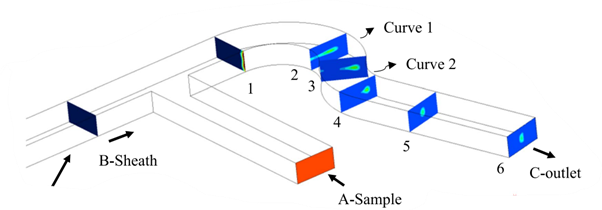The invention is a single-layer microfluidic device designed for three-dimensional hydrodynamic focusing of a sample fluid using a sheath fluid. The device uses curves in a microchannel to achieve complete 3D focusing with a simplified structure, reducing the need for multiple sheath inlets and complex fabrication processes.
Efficient sample management in microfluidic systems is crucial for various biomedical and analytical applications therefore it becomes necessary to analyze the sample through hydrodynamic focusing. Existing methods are often complex, involving multi-layered structures and multiple sheath inlets, making them difficult and expensive to fabricate. Additionally, these methods can suffer from low throughput and difficulty in controlling the sample flow.
- Simplified fabrication: The single-layer design, which is fabricated of Polydimethylsiloxane (PDMS), reduces complexity and cost.
- Effective 3D focusing: Complete 3D focusing is achieved with a single sheath inlet, which simplifies the design and reduces the need for additional pumps.
- High throughput: It is capable of high flow rates, enhancing sample processing efficiency.
- Versatility: It is suitable for various applications including flow cytometry, optical waveguides, and more.
- Curved microchannel design: It utilizes two curvatures to achieve vertical and horizontal focusing.
- Hydrodynamic focusing: It achieves complete 3D focusing by using secondary flows generated by the curves.
The present prototype includes the following:
- A microchannel fabricated in a single layer of PDMS, featuring a sheath fluid inlet, sample fluid inlet, and an outlet
- Two curved sections for focusing the sample fluid in both the horizontal and vertical directions
Tested with different flow rates, it demonstrated effective 3D focusing of blood cells.
The present prototype has been developed and tested with different flow rates, demonstrating effective 3D focusing of blood cells.
3
Its simplified fabrication and operation reduce costs in research and industrial applications. It has potential applications in flow cytometry for better detection and analysis of biological samples.
It has applications in Microfluidic Industries - Diagnostics and Healthcare, Pharmaceuticals, such as:
- Flow cytometry: Employed in medical research and diagnostics to count and examine cells and particles
- Biomedical research: Ideal for studying various biological samples such as blood cells and bacteria
- Chemical analysis: Enables precise control and measurement of fluid samples in chemical experiments
- Microfluidics research: Essential for development and testing new microfluidic devices and applications
- Optical waveguides: Enhances the precision of light guidance in optical applications
Geography of IP
Type of IP
96/MUM/2015
466810

